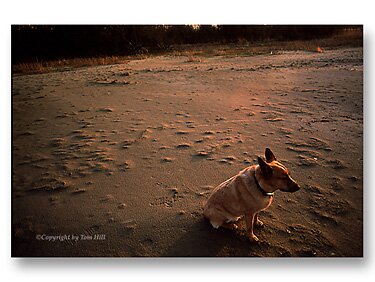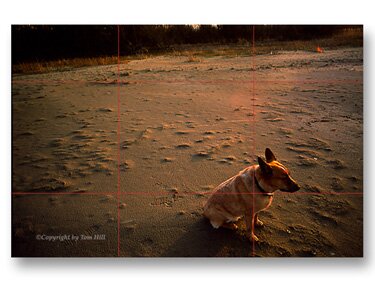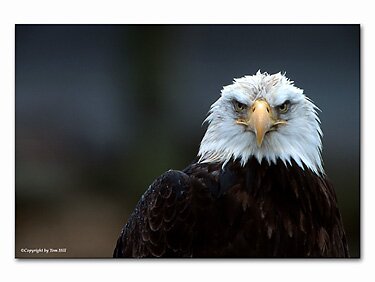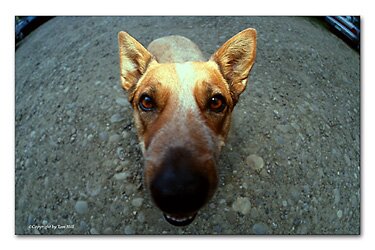

All Images And Text On This Site Are Copyright 1999-2001
by
Thomas D. Hill Jr.

| ABOUT KEIKO |
| WHAT'S NEW |
| THE KEIKO GALLERY |
| EQUIPMENT |
| IMAGE OF THE MONTH |
| ARTICLE OF THE MONTH |
25 June 01
As they say, "there's a million ways to skin a cat". No question I'm a dog lover, no offense to cat lovers out there. The point is there are a million ways to compose images. I'll talk about one of the most classic techniques--The Rule Of Thirds"--and hopefully, you'll begin to understand how to compose your images slightly better. First point I want to make is, in the end, "rules are made to be broken". If you haven't guessed by now, not all rules need to be applied all the time. There's nothing wrong with going against the grain. There may be a problem with making interesting images--that's why there are rules to help. But, when a technique is mastered, there's no reasons for not paying attention to the rules. But, before breaking the rules you have to understand the guidelines in the first place. You have to know where you've been to really understand where you're going.
The Rule of Thirds is about placing the subject within the boundaries of your image to keep things interesting. Sure you could easily just keep the subject right in the middle of the frame, equal distance from left, right, top, and bottom of your picture. But that would take any excitement away from your image. It would look kind of non-interesting. In fact, I think for most subjects, placing the object in directly in the middle of the frame detracts from the interesting aspects of your image. It's a negative contribution. No one wants that do they?
How do we apply this rule? It's extremely simple. Draw lines 1/3 and 2/3's across and top to bottom of your image. This makes a grid of nine boxes with the four lines. The grid isn't interesting except for the intersection of all these lines. There are four intersections on the image. This is where you place your subjects.

Usually, when the rule is applied the subject has room to move--breath--within the confines of the frame. It's meant as an opportunity to over-come the constraints of this medium. Remember, you're portraying an environment without limits within the borders of a small 35mm image. Using the Rule of Thirds this way minimizes any feelings that the border is keeping your subject stationary. I think it promotes making your subject look alive but making subtle suggestions it has somewhere to go within your picture. Also, you could use this rule when the subject is looking directly at you. That means it isn't looking in any particularly direction. In this case, the idea is access the feeling of where he might be going. Then compose the image so he has the open space to move into. I'll show some more examples here in a bit.
Hooker's location here is the antithesis of this concept. He's looking towards the smaller part as if there's something more interesting off the edge of the image. If anything it directly conflicts from the "rule" and makes the image slightly more "eye catchy". Also, this supports the idea he's "guarding" this stretching of beach. We don't know what he's guarding the beach from. That's left up to the viewer's imagination. I think it promotes the idea Hooker is less important to the over-all image than the concept that the beach needs to be guarded for some reason.

Here's the break down of how to apply the Rule of Thirds:
1) First, draw lines at the 1/3, 2/3d's location from the left, right, top, and bottom of your image. Note, some cameras already have these lines drawn on their view screens making things easier. Those of you like me who don't have that feature can rejoice in knowing the Rule of Thirds is simple enough that such crutches aren't needed. We're smart enough not to need it.
2) Access which direction the subject's head is pointed or what direction it's moving.
3) Place the subject at the appropriate intersection that allows the movement or pointing into the larger portion of the image.
4) Watch the positioning so important parts of the subject aren't cut off by placing it at that intersection.
5) Finally, after reviewing everything, break all the rules and do what looks "neat".
One last thing I'll add is today's modern auto-focus technology directly affects how this rule is applied. Most AF sensors are located directly in the middle of the view screen which conflicts with the Rule of Thirds. Nothing in the rule says "put the subject in the middle". The problem is some people are so entrenched with using their AF technology, they forget to use the rules. If the technology doesn't support your method of photography, then either change the technology or don't use it. I conquered the problem with my Nikon F5 by specifically not depending on my AF sensor when I shoot my image. I've written an article on how I disabled the AF activation when the shutter button is depressed so I can compose my images without worrying about the focus running off. If your camera only has a single focus sensor or doesn't support the Rule of Thirds, don't depend on AF when shooting static subjects. It will only make your images boring.
There you have it, the Rule of Thirds. It'll make your images more interesting and hopefully get you away from all those snap shots of the dog where he's smack in the middle of the picture.
Cheers
Tom
